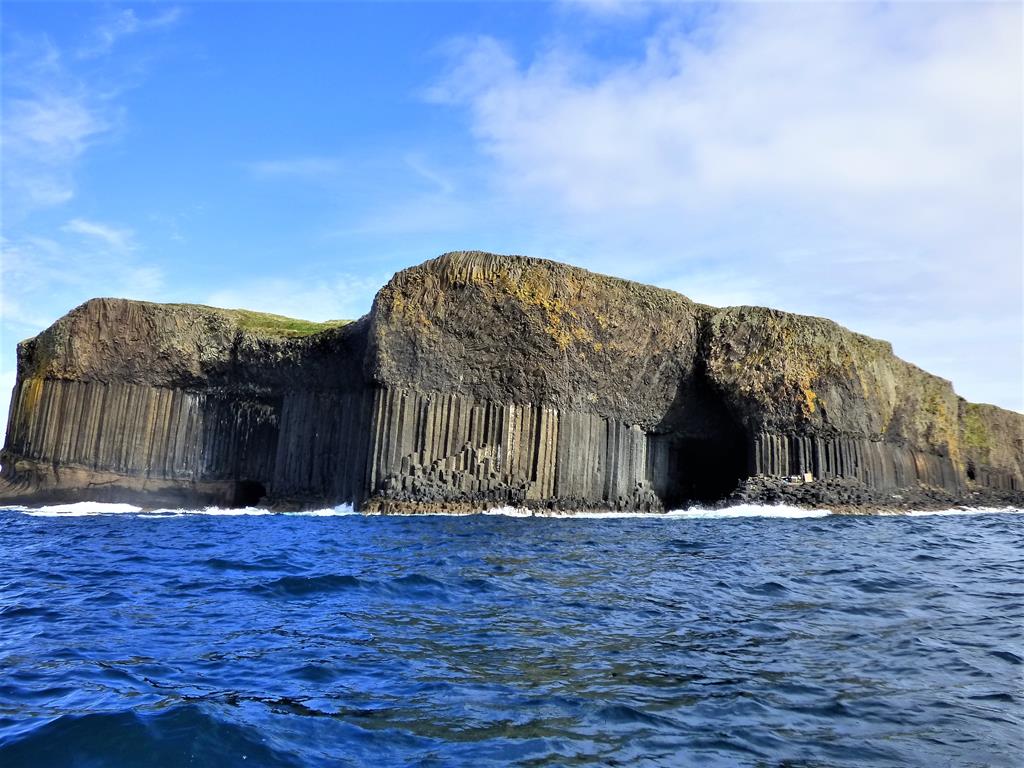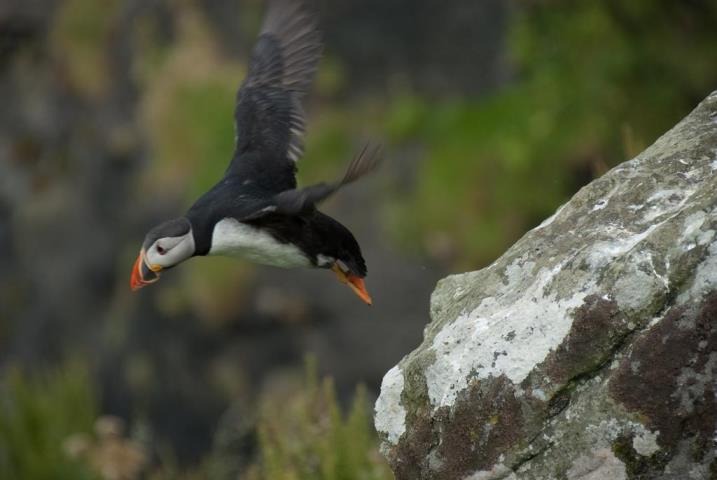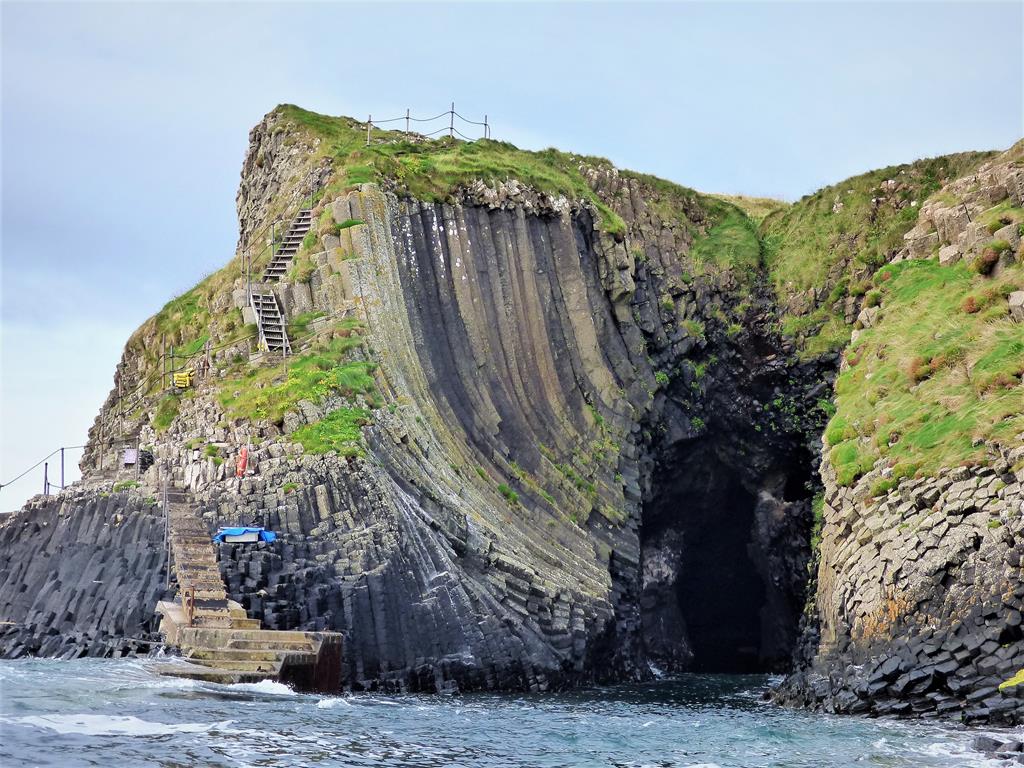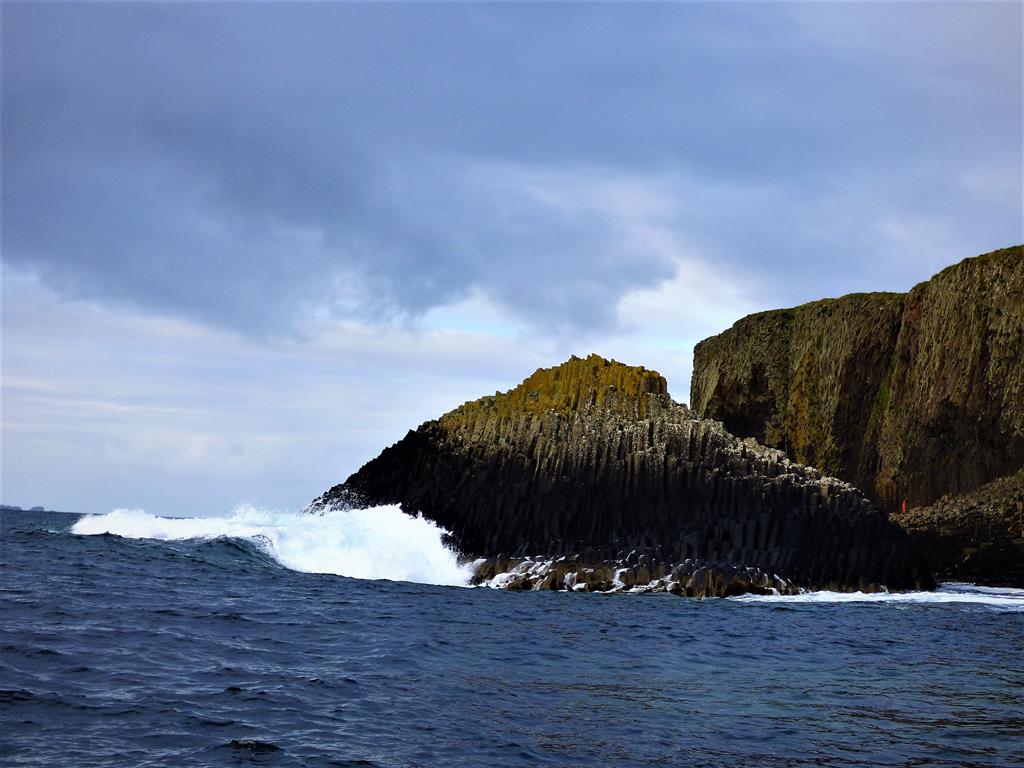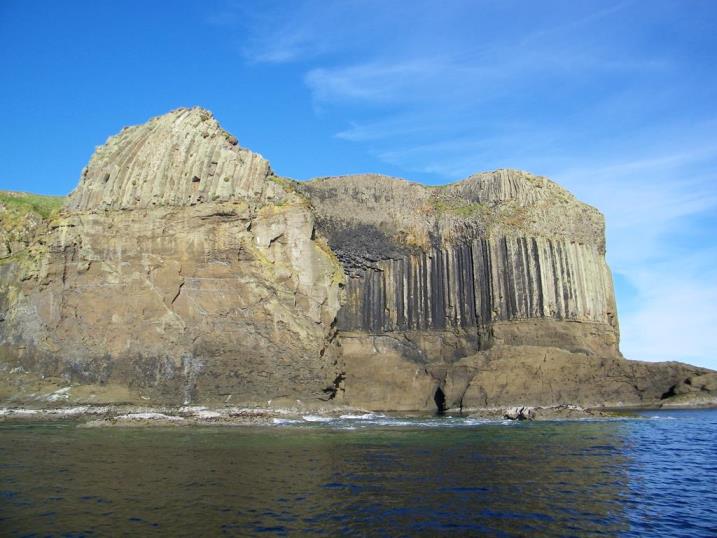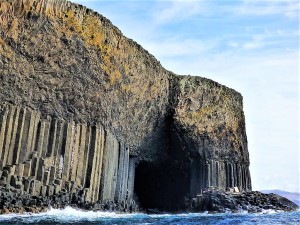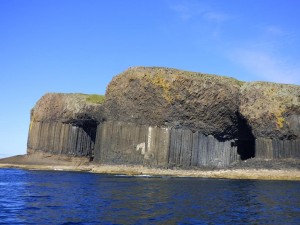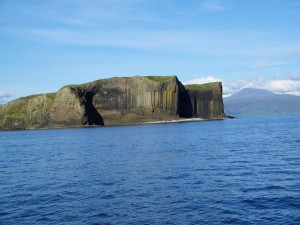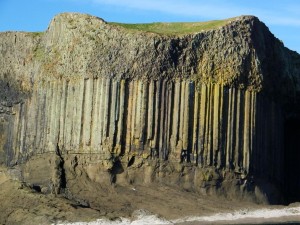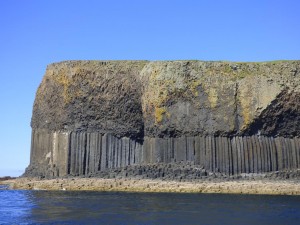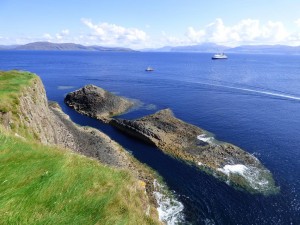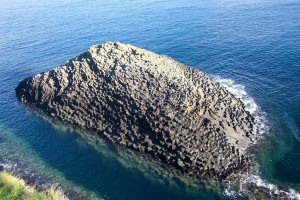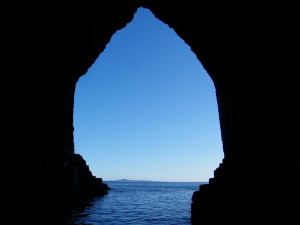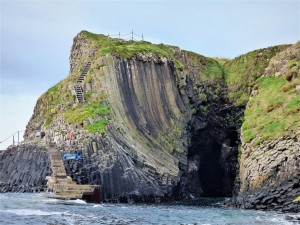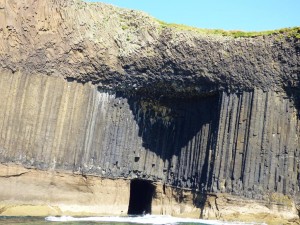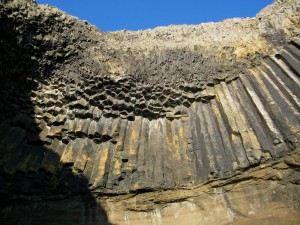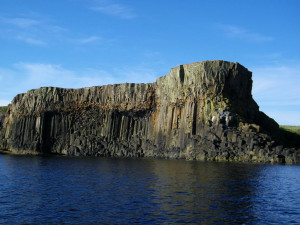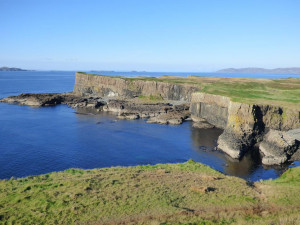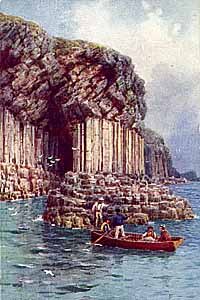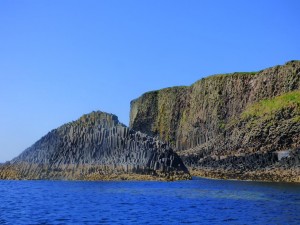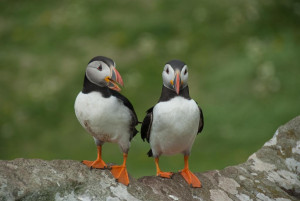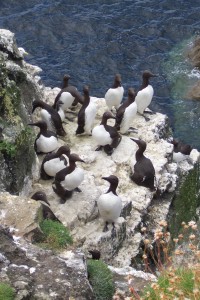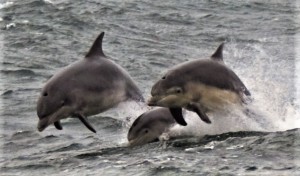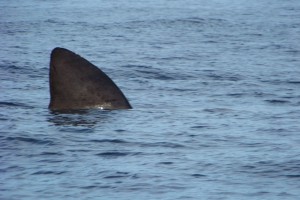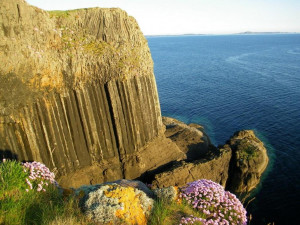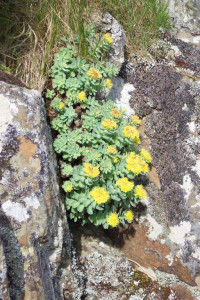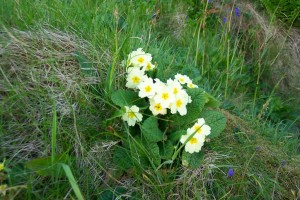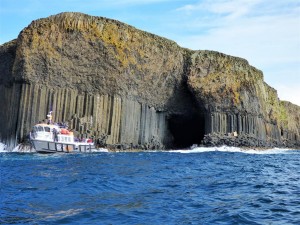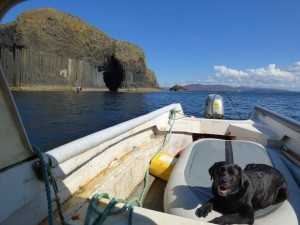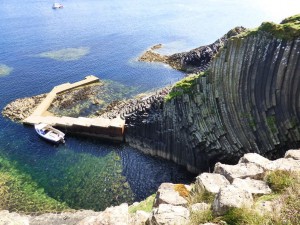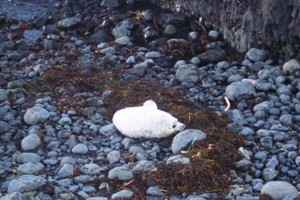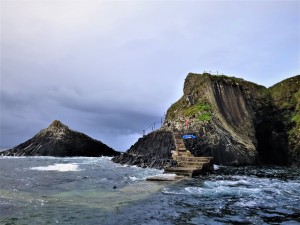Staffa - A Spectacular Natural Wonder!- Sculpted by Nature! Voyage to World Renowned Fingal's Cave.
Staffa (Pillar Island)
A beautiful and uninhabited island (approximately 80 acres) lying 6 miles north of the Isle of Iona to the west of the Isle of Mull. It is home to hundreds of seabirds and set within waters teeming with marine life.
Staffa is best known for its magnificent basalt columns. Their effect is most overwhelming at An Uamh Binn (Musical Cave) or, as it is more commonly known, Fingal's Cave, which has enthralled and inspired travelers for hundreds of years. Staffa is owned and managed by The National Trust for Scotland.
click to enlarge all images
 The Isle of Staffa in 1973 was declared a Site of Special Scientific Interest and in 2001 it was designated a National Nature Reserve.
The Isle of Staffa in 1973 was declared a Site of Special Scientific Interest and in 2001 it was designated a National Nature Reserve.
The name 'Staffa' is thought to come from an Old Norse word meaning wooden building staves (which look similar to the island's basalt
columns). The name is a reminder of the region's Viking history, and that people have marvelled at Staffa's basalt columns for centuries.
We have made the trip out to Staffa many times - sometimes with the tour operators and sometimes in our own boat The Wanderer.
We never cease to be amazed at the wonder of this natural phenomenon especially as each time we go we seem to see something different. Getting up close to the puffins and sitting among them to take photographs is great fun and we bring back treasured memories and moments every time.
The Making of Staffa
About 60 million years ago intense volcanic activity in the area, and specifically on Mull led to a blanket of lava being fed far out into the Atlantic. Most has been eroded and dispersed, but Staffa, the Treshnish Islands and other small islands have remained as stubborn outcrops. As the west coast of Scotland was stretched huge amounts of magma (hot liquid rock) rose up through the cracks in the Earth's crust, erupting as lava and volcanic ash onto the surface. This volcanic activity lasted many hundreds of thousands of years and eventually created a 2.2 km plateau of lava and ash. This is of course a simplification of a complex geological story. Scotland and North America were being pulled apart by continental drift to form the north-eastern Atlantic.
Staffa Geology
Consisting of three layers of rock of different types, covered with a surface of rich soil and lush grass. The lowest layer if tuff, compressed volcanic ash and dust; the middle layer is composed of the basaltic columns; and the uppermost is made up of jumbled and fractured columns and volcanic debris.
If you look at the western cliffs of Burg on Mull, you can see more than 20 stacked-up lava flows. Staffa's columns form one of the very lowest and oldest of these flows.
Over time, rivers, wind, ice and sea have deeply eroded the lava plateau. Today, only patches of the once extensive basalt flows are left at Staffa, the Treshnish isles and parts of Mull as well as extending under the water to the Giant's Causeway, County Antrim in Northern Ireland
Staffa's amazing basalt columns formed within a single massive flow of lava as it cooled and solidified in a very gradual and controlled
manner. As the material cooled it volume shrank slightly and the narrow spaces which separate the columns were created, similar in
concept to the release of tightly grasped bundle of cigarettes or the drying-out of the earth floor of a pond.
Theoretically, every column should be perfectly hexagonal in section if the cooling process had occurred uniformly; but there would have been a multitude of minor variations in the rock itself and in the pattern of cooling, leading to the considerable variety in column size and form that we can see.
When the columns were taking shape a persistent white deposit settled in the spaces left by the contraction of the rock. This substance
Staffa's main physical features include the five principal caves and the Causeway of snapped columns which links Fingal's Cave with Clamshell Cave. Port an Fhasgaidh, Gaelic for Shelter Haven but commonly known as the Old Harbour is the only beach on the island where boats can be dragged up clear of the surf.
The highest point is Meall nan Gambna, The Hill of the Stirks (or Heifers), 135 feet above low water. Two islets are given names on Ordnance survey maps - they are Am Buachaille, The Herdsman, alongside the Causeway, composed entirely of twisted columns and Eilean Dubh The Black Isle which is home to several sea-bird colonies.
Most of Staffa's sea caves were formed by waves crashing against a soft layer of volcanic ash underneath the basalt columns. However, a formation of Fingal's Cave within the hard layer of basalt columns was slightly more complicated.
Fingal's Cave
Fingal’s Cave is unique, making it one of the best known caves in the world and we are often asked how was it formed? The answer is quite straight forward - sight of Staffa from the south shows that most of the visible part of the island that can be seen slopes downwards to the east. The exception is the portion to the right or east of the cave.
Since the layer of rock made up of columns would all have been laid down at one time it follows that when the tilting occurred there would have been pressure above the present site of the cave, and a fissure would have been forced open directly below, where the sea now surges in.
The violent action of huge waves that would have struck the island during storms over thousands of years developed the fissure, undermining dozens of columns, to create the opening we marvel at and call Fingal's Cave.
The origin of the name 'Fingal's Cave' is wrapped in myth. Around 250 A.D. Finn MacCumhaill, or Fingal, was possibly an irish general who had a band of faithful warriors - a Celtic parallel to King Arthur and his Round Table. Fingal is supposed to have been the father of Ossian, traditional bard of the Gaels.
Gaels migrated into Scotland from Ireland until the Norsemen began their raids on the Scottish coast, and the stories of Fingal would doubtless have come across too. Soon he became revered in Scotland and boosted by the Ossianic heroic verse and sings, his name was a natural choice to assign to this dramatic and awe-inspiring cavern.
Staffa's Other Caves
There are four other important caves on Staffa, all clustered around the southern part of the island. Taking them clockwise they are Clamshell Cave, Boat Cave, MacKinnon's Cave and Cormorants' Cave.There is a further captivating feature called the Gunna Mor.
Clamshell Cave is the best known landing place on Staffa. It is linked to Fingal's Cave by the Causeway and to the island's plateau by a stairway. The rock formation at Clamshell Cave is remarkable, it's long bent columns resembling the ribs of a wooden ship as much as they do a clamshell or scallop. This bizarre structure is faced across the narrow void of the cave by a wall of exposed column-ends, like a giant honeycomb.
Columns curve in, away form the sea. So unusual is this kind of distortion that the place on Staffa where it occurs is often called The Bending Columns. Perhaps, when the flow here was cooling, the tops of the columns were better insulated than elsewhere and so remained for longer in a plastic state. As further weight was added above, the columns would have been able to yield to it. The other three caves are formed completely in the tuff, below the stratum of columns.
Boat Cave appears from the sea (left), to be no more than an uninteresting rectangular opening in the shallow below the Colonnade. But once inside, the walls are found to be yellow, smoothly sculpted into fascinating, continuously undulating surfaces; and the roof is seen to be composed of the apparently unsupported columns above.
MacKinnon's Cave runs more than 200 feet into the island, with a lofty feel and a distinctive arrangement of rock columns, buttresses and boulders; and it is the haunt of large numbers of sea-birds. Abbott
MacKinnon of Iona is said to have come to the cave to seek forgiveness after breaking his monastic vows (by "intriguing with Matilda of Skye"), but found it too noisy and moved to Mull, to the spot near Gribun where there is another MacKinnon's Cave.
The entrance to Cormorants' Cave is hard to see. It looks as if it is just a slash in the rock wall forming the southern flank of the Old Harbour, though actually the cave goes back for over 60 feet. A little way inside there is a narrow opening to a tunnel on the right hand side; at low-water on a still day it is possible to walk dry-shod to Cormorants Cave, through this winding, dark slippery tunnel to emerge at the back of MacKinnon's Cave which, from that approach, is glistening and impressively vast and resonant.
On the northern wall of the Old Harbour is a singular recess in the cliff, several feet above the high-tide line. What is seen is the bottom of the Gunna Mor, or 'big gun', a steeply inclined and almost uniform bore about 15 feet in length. When a heavy swell strikes the cliff the air in the Gunna Mor is driven back and compressed. Upon being released it is said to make a considerable noise, reported by a visitor in 1802 to escape "with a noise like loud thunder which is heard at a great distance".
Island Archaeology
Until about 250 years ago people used to live on Staffa. When the illustrious scientist Sir Joseph Banks landed on Staffa in 1772 he found the island occupied by a solitary
'peasant who attends some cattle that pastures there".
Faujas, the French geologist, visiting Staffa in 1784 found the population to be 16, living in two huts"constructed of unhewn blacks of basalt roofed over with sods. There were eight cows, one bull, twelve sheep, two horses, one pig, two dogs, one cock and eight hens". When Professor T. Garner went to Staffa in 1798 he also found two huts and commented that "the manner of life is extremely simple, food consisting chiefly of milk and potatoes with now and then a little fish". That was the final year in which the island was lived on continuously. Thereafter for the following decade, herdsmen and their families resided on Staffa from spring to autumn and then habitation came to an end.
Animals, however have gone on spending time on Staffa. A visitor in 1826 reported finding cows, horses and sheep "without a guardian and without shelter". Until recently sheep were still grazed on the island and we still hear of tales and exploits from some of the older residents in the village of livestock being ferried out in boats to spend the summer on the island grazing. The mind boggles at the thought of the animals negotiating that steep stairway up to the top of plateau on the island - surely there must be another way up!
As you walk across the island you may notice low undulating lines of 'rig and furrow' agriculture (also known as 'lazy beds) and several stone buildings. The lazy beds were used to grow potatoes necessary for their survival and surprisingly, in view of the harsh weather, oats grew moderately well too. Most of the surface of the island was cultivated at some time; though latterly some was stripped of turfs to burn, setting back the possibility of growing crops.
Staffa's largest surviving building is a stone ruin, still visible today, which was long believed to be the remains of a medieval chapel or hermit's cell. It's presence was not noted by any visitor before 1930, the year in which Pancoucke included the roofless building in his painting of Staffa's plateau. Now it is widely assumed that the structure was a folly erected in the 1820's. Over the years, the building, in various stages of collapse has provided visitors with shelter from the weather
Notable Visitors to Staffa
Fingal's Cave was brought to the attention of the wider world by the famous botanist Joseph Banks in 1772. He wrote: "Compared to this what are cathedrals or palaces built by men! Mere models or playthings, imitations as his works will always be when compared to those of nature."
At the time, the Romantic Movement was spreading across Europe with its emphasis on wilderness, emotion and natural splendour. Staffa, with itwild beauty, soon became one of the 'must see' sights on the Highland Tour. Throughout the 19th century Staffa was visited by a variety of well-known individuals who were all captivated and inspired by the magic of the island.
These included Alfred Lord Tennyson, Queen Victoria, Jules Verne, Joseph Turner (who painted a wonderfully turbulent seascape of waves crashing in at Fingal's Cave), William Wordsworth, Keats, Johnston & Boswell, Robert Louis Stevenson and Sir Walter Scott who wrote:
"one of the most extraordinary places I ever behold. It exceeded in my mind every description I had heard of it, composed entirely of basaltic pillars as high as the roof of a cathedral, and running deep into the rock, eternally swept by a deep and swelling sea and paved, as it were, with ruddy marble, baffles all description.”
The island became internationally renowned through Felix Mendelssohn's Hebrides Overture (Fingal's Cave). He wrote that the inspiration for this piece of music came through a visit to the island in 1829, while he was standing in the cave listening to the roar of the waves. Such was the inspiration that every year in June, Mendelssohn's music is celebrated with a Mendelssohn on Mull festival.
Bird Paradise
There are important colonies of seabirds that breed on Staffa and as you approach the island during the summer months, you will notice the variety of birds flying to and from the island. The island is the nesting place for a whole range of species including puffins, cormorants, shags, kittiwakes, fulmars, great black-backed gulls, skuas and razorbills.
Puffins are a particular favourite with visitors because of their brightly coloured beaks and clown-like appearance. Puffins nest in burrows and rocky crannies around Staffa where they lay one egg during the summer months. Their main food is san eels which they catch by diving up to 60 m into the sea.
Puffins start arriving between March/April where they form 'rafts' on the water and gradually come ashore to nest. Between May & June, the chicks hatch. In July the parents care
for the chick at the nest and in early August the parents abandon the nest. After several days the chick follows. Puffins mass on the sea and then fly off to the mid-Atlantic for the winter.
The above photo of the puffin was taken by John on 19 June 2012 when he sailed out to Staffa in the evening with Jane's dad 'The Admiral'. The puffins were all in their burrows getting ready to settle for the night and popped out to see who was visiting them 'out-of-hours'.
Marine Life
The sea around Staffa acts as a food store for the island's bird life. However underneath the surface there is a rich diversity of creatures besides fish, including jellyfish, crustaceans, algae and marine mammals.
Keep your eyes peeled when travelling to Staffa. You may see some of these creatures, in particular the mammals, which unlike fish must come to the surface for air. Dolphins and porpoises are often seen surfacing between the waves, while along the shores of Mull you might spot colonies of grey seals basking on the rocks.
Atlantic seals are known to come to Staffa in the early autumn to give birth to their white furry pups. In the sea and around the island seals are often in evidence; and fisherman can be seen catching crabs, lobsters and other fish.
Changing Blooms
The diverse pattern of soil types on Staffa arising form the basaltic lavas, allows a great range of plant communities to flourish. The 150 different higher plants constitute an unusually rich flora for so small an island.
Until 1997, Staffa was grazed by sheep, brought over by crofters from Iona. However, grazing is no longer practical on the island and all livestock has been removed. The vegetation has since become taller and thicker making the ground more difficult to walk across. It has however allowed the wild flowers to grow - plants to look out for include wild thyme and bird's-foot trefoil on shallow rocky soils, white flowered brook weed in wet areas and yellow flowered tormentil on dry heath-land.
Despite this wealth of plant life, there is almost no bracken; and no heather, trees or shrubs. However, plentiful colour is provided by the sea campion, thrift, buttercup and by the rich lichens on the south-facing colonnade near the major caves. Thus while the exceptional geological features are recognised as being of outstanding importance, the whole island's ecosystem which embraces its rocks, soil, climate, topography and the influences of its marine location is precious.
Getting to Staffa
See Iona and Staffa with Staffatrips or Staffatours to the Isle of Staffa:
 Departs up to 4 times daily from Fionnphort pier (9.45am 10.00 a.m, 12.15pm and 2 pm) & Iona
Departs up to 4 times daily from Fionnphort pier (9.45am 10.00 a.m, 12.15pm and 2 pm) & Iona
(9.30am 9.45am 12.00pm and 2.00pm . from April through to the end of October. Sailing time is 40 to 50 minutes with an hour spent ashore on
Staffa (weather and sailing conditions permitting) to visit the spectacular atmospheric Fingals Cave with its splendid basalt columns formed 59 million years ago and see the bid and wild life, especially the Puffins. Please wear warm waterproof clothing and practical footwear for climbing the stairs to the top of the cliff. In season puffins can be seen ashore, also guillimots, fulmars,great skuas, eider ducks, gannets, kittiwakes, black backed gulls, great northern divers, and razor bills. With luck occasionally you will see whales,dolphins,porpoises,basking sharks and otter.
The trip lasts about 3 hours and you can leave the ferry at Fionnphort or Iona.
Seaview accommodation is ideally situated 2 minutes away from Fionnphort pier to allow you to take the trip to Staffa and visit Iona easily.
John and Jane recommend you book the trip through them on arrival at Seaview allowing flexibility when deciding when you take tour weather permitting. For full details and images on Treshnish Isles go to Treshnish Page.
Wildlife Timetable:
Puffins-mid April to end of April sometimes first week in August
Guillimots and razorbills April-July
Kittiwakes and Shags-April to end August
Common seal pups-June Atlantic seal pups September to end of November
Basking Sharks-Mid June to September
Dolphins,whales and porpoises possible most of the year
MB Iolaire of Iona - , Graham and Sara Tindal, Isle of Iona.
|
W: www.staffatrips.co.uk |E: iolaire@staffatrips.co.uk
MB Fingal of Staffa & MV Ullin of Staffa - Staffatours, Isle of Iona
W: www.staffatours.com | E: fingal@staffatours.com
Facebook and TripAdvisor
Last amended 29 January 2019
Seaview 4 star gold bed and breakfast©2001-2019 "Gateway to the Sea Kingdom

